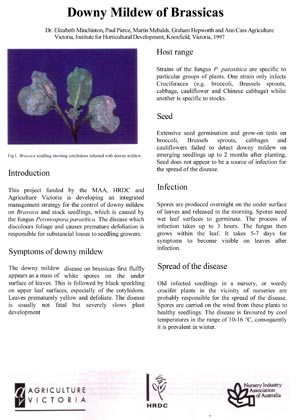|
|
This project funded by the MAA, HRDC and Agriculture Victoria has developed an integrated management strategy for the control of downy mildew on Brassica and stock seedlings. The disease is caused by the fungus Peronospora parasitica which discolours foliage and premature defoliation. The disease is responsible for substantial losses to seedling growers.
Host range : One strain only infects Cruciferacea (e.g. broccoli, Brussels sprouts, cabbage, cauliflower and Chinese cabbage) whilst another is specific to stocks. Seed : Seed does not appear to be a source of infection for the spread of the disease. Infection : Spores need wet leaf surfaces to germinate. The process of infection takes up to 3 hours. The fungus then grows within the leaf. It takes 5-7 days for symptoms to become visible on leaves after infection. Spread of the disease : Spores are carried on the wind from these plants to healthy seedlings. The disease is favoured by cool temperatures in the range of 10-16 °C, consequently it is prevalent in winter. Strategies to control the disease must consist of both management practices and fungicides spray programs. Management strategies to reduce the disease include :
Evaluation of Fungicides : Growing cauliflower seedlings under cover (2 weeks under glass, 2 weeks under cloth and 4 weeks outside) slows down the initial development of downy mildew, compared with growing them without cover (2 weeks under glass, 6 weeks outside). A combination of the contact fungicide ‘Euparen’ + the systemic fungicide ‘Foli-R-Fos’ controlled downy mildew on seedlings grown with or without cover. ‘Euparen’ which was applied with ‘Agral 60’, was not phytotoxic but produced greening of foliage on seedlings. Neither ‘Foli-R-Fos’ nor ‘Euparen’ are currently registered for control of downy mildew. Fungicides registered for the control of downy mildew on brassicas are copper, copper oxychloride, cupric hydroxide, Mancozeb, Metiram and Zineb. Furalaxyl is registered for ornamental seedlings. All are contact fungicides except Furalaxyl, which is a systemic. |
||||||||
|

